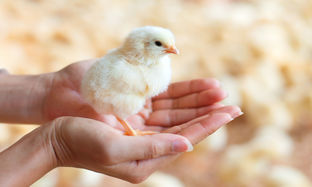
Chicken pecking: how to avoid it?
In a group of chickens, pecks fuse, feathers fly…
A hierarchy is set up, and beware of those who do not comply with the rules established by the dominant chicken. This transient hierarchical pecking is necessary for the balance of the group. On the other hand, pecking linked to a nutritional deficiency or to the environment has more serious consequences. The injuries inflicted can be deep. It is advisable to adjust the living conditions and feeding of the hens.
A hen is not made to live alone. She likes the company of her peers.
But keep in mind that in a group (even of 2), a hierarchy will settle. The dominant hen will rule her law. For example, she may not tolerate other hens coming to eat next to her. She will be the first to go lay eggs in the nest, and her location on the perch will be the highest possible, thus imposing her superiority. At the manger, pecks on the head and intimidation are in order. Do not interfere, just observe and make sure it does not go ‘too far’. Generally, these type of pecks do not cause injuries.
This behavioural disorder must be detected in order to correct the problem, as pecking can go as far as death of the affected chickens.
Spring, with the lengthening of days, is a favourable period for the development of pecking, as the more light there is, the more nervous hens are. It must be ensured that the hens have free access to an outdoor area such as a large garden, because a high density of hens in a same enclosure is conducive to pecking. A lack of minerals and / or vitamins, a sudden change in diet, an unsuitable living environment (insufficient number of nests, feeders, water troughs and roosts) are also factors to take into account if you observe pecking. In laying hens, we can sometimes observe pecking that goes as far as disembowelment of the animal. Congeners peck the oviduct of the hen in the nest, during the prolapse that follows the oviposition (during oviposition, the vagina is externalized to deposit the egg, which avoids contact with the walls of the cloaca); this is the most serious case of pecking.
More generally, hens are attracted by the colour red; any injury will therefore favour pecking by the congeners.
Injured hens will be isolated for protection and care. Your vet will advice you on the care to be provided following the observed lesions.
Then, it will be necessary to discard the dominant subject or subjects, if you manage to identify them, to give more space to your animals, and to check the living conditions. Quickly put in place a supplementation in vitamin and minerals.
In the evening, the shelter in which your hens are housed must be large enough to accommodate one or more nests depending on the number of hens you have. We usually provide one nest for 4 to 7 hens. If they have the choice, hens prefer to sleep perched. About 18cm of perch length per hen is required. If you place several perches, the dominant hen will go to the top perch.
There too, pecking in perspective if a young hen ventures on the upper floors! Therefore, perches placed at different heights will satisfy the group. This is not always possible given the small size of hen houses sold as a kit.
Once the layout of the living space has been prepared, you can give vitamins and minerals to your chickens. Drinking water may be supplemented with a complementary product suck as Pic Stop. The distribution of the Pic Stop product is done for 10 consecutive days, according to the indications of this supplementary food.
Your chickens should gradually clam down and return to a normal behaviour.
Before pecking occurs, Pic Stop can be distributed as soon as a new hen is introduced, at each change of season, and before any change in the environment of your chickens.

